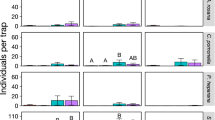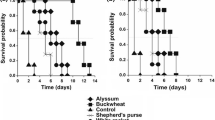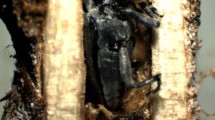Abstract
Co-occurring herbivorous pests may have shared or divergent responses to plant- and insect- derived cues, creating challenges for effective pest management in agroecosystems. We examined how behaviors of two endemic specialist herbivores of Cucurbitaceae crops, squash bugs (Anasa tristis, Hemiptera: Coreidae) and striped cucumber beetles (Acalymma vittatum, Coleoptera: Chrysomelidae) are affected by cues in the Cucurbita pepo agroecosystem. We evaluated plant resistance to squash bugs and beetles using cultivars that typify the two domesticated subspecies C. p. pepo (e.g., zucchini) and C. p. ovifera (e.g., straightneck summer squash), and tested how squash bugs respond to beetle aggregation and feeding. Across several field experiments, we demonstrated that squash bugs prefer to oviposit on C. p. ovifera over C. p. pepo, while beetles had the opposing preference. Nonetheless, there was no link between preference and squash bug nymphal survival or development. While squash bugs and beetles diverge in preference, we found that squash bugs positively respond to beetle-derived cues. More squash bug oviposition was observed on plants with greater beetle damage and, using both actively feeding beetles and synthetic lures, we demonstrate that bugs eavesdrop on and respond to vittatalactone, the male-produced beetle aggregation pheromone. Thus, squash bugs appear to exploit the cue of a co-occurring specialist beetle for host choice and this has implications for management: while there are trade-offs in varietal preference, synergistic trapping of both pests may be possible. By evaluating the behavior of co-occurring pests, management strategies with multi-species efficacy can be identified and applied in agroecologically-based pest management.





Similar content being viewed by others
References
Adler LS, Hazzard RV (2009) Comparison of perimeter trap crop varieties: effects on herbivory, pollination, and yield in butternut squash. Environ Entomol 38:207–215. https://doi.org/10.1603/022.038.0126
Andersen JF, Metcalf RL (1986) Identification of a volatile attractant for Diabrotica and Acalymma spp. from blossoms of Cucurbita maxima Duchesne. J Chem Ecol 12:687–699. https://doi.org/10.1007/BF01012102
Andrew RL, Wallis IR, Harwood CE et al (2007) Heritable variation in the foliar secondary metabolite sideroxylonal in Eucalyptus confers cross-resistance to herbivores. Oecologia 153:891–901. https://doi.org/10.1007/s00442-007-0784-1
Bates D, Maechler M, Bolker B, Walker S (2015) Fitting linear mixed-effects models using lme4. J Stat Softw 67:1–48. https://doi.org/10.18637/jss.v067.i01
Bonjour EL, Fargo WS (1989) Host effects on the survival and development of Anasa tristis (Heteroptera: Coreidae). Environ Entomol. https://doi.org/10.1093/ee/18.6.1083
Bonjour EL, Fargo WS, Rensner PE (1990) Ovipositional preference of squash bugs (Heteroptera: Coreidae) among cucurbits in Oklahoma. J Econ Entomol. https://doi.org/10.1093/jee/83.3.943
Boucher TJ (2005) Cucurbit yellow vine disease (CYVD). In Connecticut. http://ipm.uconn.edu/documents/raw2/Cucurbit ,Yellow vine disease in connecticut/cucurbit yellow vine disease in connecticut.php?aid=88. Accessed 10 Mar 2020
Brzozowski LJ, Leckie BM, Gardner J et al (2016) Cucurbita pepo subspecies delineates striped cucumber beetle (Acalymma vittatum) preference. Hortic Res 3:16028. https://doi.org/10.1038/hortres.2016.28
Brzozowski LJ, Mazourek M, Agrawal AA (2019) Mechanisms of resistance to insect herbivores in isolated breeding lineages of Cucurbita pepo. J Chem Ecol 45:313–325. https://doi.org/10.1007/s10886-019-01046-8
Brzozowski LJ, Gardner J, Hoffmann MP et al (2020a) Attack and aggregation of a major squash pest: parsing the role of plant chemistry and beetle pheromones across spatial scales. J Appl Ecol 57:1442–1451. https://doi.org/10.1111/1365-2664.13689
Brzozowski LJ, Gore MA, Agrawal AA, Mazourek M (2020b) Divergence of defensive cucurbitacins in independent Cucurbita pepo domestication events leads to differences in specialist herbivore preference. Plant Cell Environ 43:2812–2825. https://doi.org/10.1111/pce.13844
Carrasco D, Larsson MC, Anderson P (2015) Insect host plant selection in complex environments. Curr Opin Insect Sci 8:1–7. https://doi.org/10.1016/j.cois.2015.01.014
Charlery De La Masselière M, Facon B, Hafsi A, Duyck PF (2017) Diet breadth modulates preference - performance relationships in a phytophagous insect community. Sci Rep 7:1–9. https://doi.org/10.1038/s41598-017-17231-2
Chauhan KR, Paraselli BR (2017) Eight diastereomers of vittatalactone and methods of making, and methods of attracting Acalymma vittatum. U.S. Patent No. 9,718,797, 1 Aug 2017
Chomicki G, Schaefer H, Renner SS (2020) Origin and domestication of Cucurbitaceae crops: insights from phylogenies, genomics and archaeology. New Phytol 226:1240–1255. https://doi.org/10.1111/nph.16015
Cook SM, Khan ZR, Pickett JA (2007) The use of push–pull strategies in integrated pest management. Annu Rev Entomol 52:375–400. https://doi.org/10.1146/annurev.ento.52.110405.091407
Cornelius ML (2017) Ovipositional preferences of two squash bug species, Anasa tristis and Anasa armigera (Heteroptera: Coreidae), for different cultivars and species of Cucurbitaceae. J Insect Sci 18:1–5. https://doi.org/10.1093/jisesa/iey021
Cornelius ML, Buffington ML, Talamas EJ, Gates MW (2016) Impact of the egg parasitoid, Gryon pennsylvanicum (Hymenoptera: Scelionidae), on sentinel and wild egg masses of the squash bug (Hemiptera: Coreidae) in Maryland. Environ Entomol 45:367–375. https://doi.org/10.1093/ee/nvv228
Da Costa CP, Jones CM (1971) Cucumber beetle resistance and mite susceptibility controlled by the bitter gene in Cucumis sativus L. Science 172:1145–1146. https://doi.org/10.1126/science.172.3988.1145
Doughty HB, Wilson JM, Schultz PB, Kuhar TP (2016) Squash bug (Hemiptera: Coreidae): biology and management in cucurbitaceous crops. J Integr Pest Manag 7:1–8. https://doi.org/10.1093/jipm/pmv024
Fair CG, Braman SK (2017) Plant–insect interactions assessment of habitat modification and varied planting dates to enhance potential natural enemies of Anasa tristis (Hemiptera: Coreidae) in squash. Environ Entomol 46:291–298. https://doi.org/10.1093/ee/nvx043
Fatouros NE, Dicke M, Mumm R et al (2008) Foraging behavior of egg parasitoids exploiting chemical information. Behav Ecol 19:677–689. https://doi.org/10.1093/beheco/arn011
Ferguson JE, Metcalf ER, Metcalf RL (1983) Influence of cucurbitacin content in cotyledons of cucurbitaceae cultivars upon feeding behavior of diabroticina beetles (Coleoptera: Chrysomelidae). J Econ Entomol 76:47–51. https://doi.org/10.1093/jee/76.1.47
Fujita D, Kohli A, Horgan FG (2013) Rice resistance to planthoppers and leafhoppers. Crit Rev Plant Sci. https://doi.org/10.1080/07352689.2012.735986
Gardner J, Hoffmann MP, Mazourek M (2015) Striped cucumber beetle (Coleoptera: Chrysomelidae) aggregation in response to cultivar and flowering. Environ Entomol 44:1–8. https://doi.org/10.1093/ee/nvu061
Giamoustaris A, Mithen R (1995) The effect of modifying the glucosinolate content of leaves of oilseed rape (Brassica napus ssp. oleifera) on its interaction with specialist and generalist pests. Ann Appl Biol 126:347–363. https://doi.org/10.1111/j.1744-7348.1995.tb05371.x
Gregg PC, Del Socorro AP, Landolt PJ (2018) Advances in attract-and-kill for agricultural pests: beyond pheromones. Annu Rev Entomol 63:453–470. https://doi.org/10.1146/annurev-ento-031616-035040
Gripenberg S, Mayhew PJ, Parnell M, Roslin T (2010) A meta-analysis of preference-performance relationships in phytophagous insects. Ecol Lett 13:383–393. https://doi.org/10.1111/j.1461-0248.2009.01433.x
Grocock NL, Evenden ML (2020) Local and landscape-scale features influence bumble bee (hymenoptera: apidae) bycatch in bertha armyworm mamestra configurata (lepidoptera: noctuidae) pheromone-baited monitoring traps. Environ Entomol 49:1127–1136. https://doi.org/10.1093/ee/nvaa087
Haber AI, Wallingford AK, Grettenberger IM et al (2021) Striped cucumber beetle and western striped cucumber beetle (Coleoptera: Chrysomelidae). J Integr Pest Manag 12:1–10. https://doi.org/10.1093/jipm/pmaa026
Hanula JL, Berisford CW, Debarr GL (1984) Pheromone cross-attraction and inhibition among four coneworms, Dioryctria spp. (Lepidoptera: Pyralidae) in a loblolly pine seed orchard. Environ Entomol 13:1298–1301. https://doi.org/10.1093/ee/13.5.1298
Heinrichs EA (1986) Perspectives and directions for the continued development of insect-resistant rice varieties. Agric Ecosyst Environ 18:9–36. https://doi.org/10.1016/0167-8809(86)90172-6
Hoffmann MP, Robinson RW, Kyle MM, Kirkwyland JJ (1996) Defoliation and infestation of Cucurbita pepo genotypes by Diabroticite beetles. HortScience. https://doi.org/10.21273/HORTSCI.31.3.439
Howe WL, Rhodes AM (1976) Phytophagous insect associations with Cucurbita in Illinois. Environ Entomol. https://doi.org/10.1093/ee/5.4.747
Howe WL, Zdarkova EV, Rhodes AM (1972) Host Preferences of Acalymma vittatum (Coleoptera: Chrysomelidae) Among Certain Cucurbitaceae. Ann Entomol Soc Am. https://doi.org/10.1093/aesa/65.2.372
Hufnagel M, Schilmiller AL, Ali J, Szendrei Z (2017) Choosy mothers pick challenging plants: maternal preference and larval performance of a specialist herbivore are not linked. Ecol Entomol 42:33–41. https://doi.org/10.1111/een.12350
Kahn BA, Rebek EJ, Brandenberger LP et al (2017) Companion planting with white yarrow or with feverfew for squash bug, Anasa tristis (Hemiptera: Coreidae), management on summer squash. Pest Manag Sci 73:1127–1133. https://doi.org/10.1002/ps.4427
Kessler A (2015) The information landscape of plant constitutive and induced secondary metabolite production. Curr Opin Insect Sci 8:47–53. https://doi.org/10.1016/j.cois.2015.02.002
Kos SP, Klinkhamer PGL, Leiss KA (2014) Cross-resistance of chrysanthemum to western flower thrips, celery leafminer, and two-spotted spider mite. Entomol Exp Appl 151:198–208. https://doi.org/10.1111/eea.12185
Lankau RA (2007) Specialist and generalist herbivores exert opposing selection on a chemical defense. New Phytol 175:176–184. https://doi.org/10.1111/j.1469-8137.2007.02090.x
Majumdar A, Price M (2019) Special collection: trap and cover major lessons from large-scale trap cropping demonstrations for pest reduction in vegetables. Ann Entomol Soc Am 112:298–301. https://doi.org/10.1093/aesa/say059
Margolies DC, Nechols JR, Vogt EA (1998) Rapid adaptation of squash bug, Anasa tristis, populations to a resistant cucurbit cultivar. Entomol Exp Appl 89:65–70. https://doi.org/10.1046/j.1570-7458.1998.00382.x
Metcalf RL, Lampman RL (1989) The chemical ecology of Diabroticites and Cucurbitaceae. Experientia 45:240–247. https://doi.org/10.1007/BF01951810
Metcalf RL, Metcalf RA, Rhodes AM (1980) Cucurbitacins as kairomones for diabroticite beetles. Proc Natl Acad Sci 77:3769–3772. https://doi.org/10.1073/pnas.77.7.3769
Miller JR, Cowles RS (1990) Stimulo-deterrent diversion: a concept and its possible application to onion maggot control. J Chem Ecol 16:3197–3212. https://doi.org/10.1007/BF00979619
Morris BD, Smyth RR, Foster SP et al (2005) Vittatalactone, a beta-lactone from the striped cucumber beetle, Acalymma vittatum. J Nat Prod 68:26–30. https://doi.org/10.1021/np049751v
Novero ES, Painter RH, Hall CV (1962) Interrelations of the squash bug, Anasa tristis and six varieties of squash (Cucurbita spp.). J Econ Entomol 55:912–919. https://doi.org/10.1093/jee/55.6.912
Paris HS (2000) History of the cultivar-groups of Cucurbita pepo. In: Janick J (ed) Horticultural Reviews. Wiley, Hoboken. https://doi.org/10.1002/9780470650783.ch2
Phillips BW, Gardiner MM (2016) Does local habitat management or large-scale landscape composition alter the biocontrol services provided to pumpkin agroecosystems? Biol Control 92:181–194. https://doi.org/10.1016/j.biocontrol.2015.10.001
Poelman EH, van Loon JJA, van Dam NM et al (2010) Herbivore-induced plant responses in Brassica oleracea prevail over effects of constitutive resistance and result in enhanced herbivore attack. Ecol Entomol 35:240–247. https://doi.org/10.1111/j.1365-2311.2010.01179.x
R Core Team (2017) R: a language and environment for statistical computing. R Foundation for Statistical Computing, Vienna, Austria. https://www.R-project.org/
Rodriguez-Saona C, Stelinski LL (2009) Behavior-modifying strategies in IPM: theory and practice I pest. In: Peshin R, Dhawan A (eds) Management innovation-development process. Springer, Dordrecht. https://doi.org/10.1007/978-1-4020-8992-3_11
SAS Institute Inc. (2018) SAS v9.4. Cary, NC, USA
Smyth RR, Hoffmann MP (2003) A male-produced aggregation pheromone facilitating Acalymma vittatum [F.] (Coleoptera: Chrysomelidae) early-season host plant colonization. J Insect Behav 16:347–359. https://doi.org/10.1023/A:1024824025210
Smyth RR, Hoffmann MP (2010) Seasonal incidence of two co-occurring adult parasitoids of Acalymma vittatum in New York State: Centistes (Syrrhizus) diabroticae and Celatoria setosa. Biocontrol 55:219–228. https://doi.org/10.1007/s10526-009-9232-y
Spears LR, Looney C, Ikerd H et al (2016) Pheromone lure and trap color A. Environ Entomol 45:1009–1016. https://doi.org/10.1093/ee/nvw085
Stout M, Davis J (2009) Keys to the increased use of host plant resistance. In: Peshin R, Dhawan AK (eds) Integrated pest management innovation-development process. Springer, Dordrecht. https://doi.org/10.1007/978-1-4020-8992-3_7
Tallamy DW, Gorski PM (1997) Long- and short-term effect of cucurbitacin consumption on Acalymma vittatum (Coleoptera: Chrysomelidae) fitness. Environ Entomol 26:672–677. https://doi.org/10.1093/ee/26.3.672
Theis N, Barber NA, Gillespie SD et al (2014) Attracting mutualists and antagonists: plant trait variation explains the distribution of specialist floral herbivores and pollinators on crops and wild gourds. Am J Bot 101:1314–1322. https://doi.org/10.3732/ajb.1400171
Turlings TCJ, Erb M (2018) Tritrophic interactions mediated by herbivore-induced plant volatiles: mechanisms, ecological relevance, and application potential. Annu Rev Entomol 63:433–452. https://doi.org/10.1146/annurev-ento-020117-043507
Wallingford AK, Kuhar TP, Weber DC (2018) Avoiding unwanted vicinity effects with attract-and-kill tactics for harlequin bug, Murgantia histrionica (Hahn) (Hemiptera: Pentatomidae). J Econ Entomol 111:1780–1787. https://doi.org/10.1093/jee/toy109
Wang C, Yasui H, Yoshimura A et al (2004) Inheritance and QTL mapping of antibiosis to green leafhopper in rice. Crop Sci 44:389–393. https://doi.org/10.2135/cropsci2004.1039a
Weber DC (2018) Field attraction of striped cucumber beetles to a synthetic vittatalactone mixture. J Econ Entomol 111:2988–2991. https://doi.org/10.1093/jee/toy283
Weber DC, Khrimian A, Blassioli-Moraes MC, Millar JG (2018) Semiochemistry of Pentatomoidea. In: McPherson JE (ed) Invasive stink bugs and related species (Pentatomoidea): biology, higher systematics, semiochemistry, and management. CRC Press, Boca Raton
White R (1977) Sexual characters of species of Diabrotica (Chrysomelidae: Coleoptera). Ann Entomol Soc Am 70:168. https://doi.org/10.1093/aesa/70.2.168
Wilson JM, Kuhar TP (2017) A survey of the species of squash bug (hemiptera: coreidae) egg parasitoids in virginia and their distribution. J Econ Entomol 110:2727–2730. https://doi.org/10.1093/jee/tox276
Acknowledgements
We thank Elise He and the Cornell University Agricultural Experiment Station for assistance with field work in NY. For assistance with the lure experiments, we thank: Ashot Khrimian (coordinating the contracted synthesis of mixed vittatalactone), Filadelfo Guzman (lure preparation), Philip Brand, Tyler Murray, and Sarah Cox (assistance at New Hampshire field sites), Megan Herlihy and Alexander Bier (assistance acquiring Maryland trapping data), Mary Cornelius, George Meyers and the BARC-West farm crew (use and maintenance of Maryland squash plantings), Ariela Haber (SAS data analysis). Members of the Agrawal laboratory also provided insightful comments on earlier versions of this work.
Funding
This research was partially supported by Multistate (NE-2001) and Hatch (2018–19-135) projects from the USDA National Institute of Food and Agriculture allocated through Cornell University. LB was funded by Seed Matters Graduate Student Fellowship (2015–2020).
Author information
Authors and Affiliations
Corresponding author
Ethics declarations
Conflicts of interest
The authors declare that they have no conflict of interest. LB, AW, DW and AA declare they have no conflict of interest. MM is the co-founder of Row 7, an organic seed company.
Additional information
Communicated by Jay Rosenheim.
Publisher's Note
Springer Nature remains neutral with regard to jurisdictional claims in published maps and institutional affiliations.
Rights and permissions
About this article
Cite this article
Brzozowski, L.J., Weber, D.C., Wallingford, A.K. et al. Trade-offs and synergies in management of two co-occurring specialist squash pests. J Pest Sci 95, 327–338 (2022). https://doi.org/10.1007/s10340-021-01379-y
Received:
Revised:
Accepted:
Published:
Issue Date:
DOI: https://doi.org/10.1007/s10340-021-01379-y




